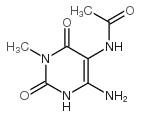Acetylator phenotype in patients with p-phenylenediamine allergy.
Y Kawakubo, M Nakamori, E Schöpf, M Ohkido
Index: Dermatology 195(1) , 43-5, (1997)
Full Text: HTML
Abstract
p-Phenylenediamine (PPD) has been widely distributed as hair dye ingredient and may be responsible for contact dermatitis. Since not all the subjects exposed to PPD react to the substance, we tested a possible predisposing factor of cutaneous drug metabolism.Eighty-five patients were selected on the basis of their patch test result for PPD. The acetylator status of patients was estimated using HPLC analysis of urinary caffeine metabolites.Among patients with a negative result for PPD, there were three groups, i.e. fast, intermediate and slow acetylators, just as in the healthy population. However, we could not find any rapid acetylator in the PPD-sensitive patient group, and slow acetylators were more often encountered in this group (p < 0.05).The acetylator phenotype might be a good marker for the cutaneous sensitivity to PPD.
Related Compounds
| Structure | Name/CAS No. | Molecular Formula | Articles |
|---|---|---|---|
 |
N-(6-amino-3-methyl-2,4-dioxo-1H-pyrimidin-5-yl)acetamide
CAS:19893-78-8 |
C7H10N4O3 |
|
Caffeine as a metabolic probe: validation of its use for ace...
1991-06-01 [Clin. Pharmacol. Ther. 49(6) , 648-57, (1991)] |
|
An alternative test for acetylator phenotyping with caffeine...
1987-11-01 [Clin. Pharmacol. Ther. 42(5) , 509-13, (1987)] |
|
Extractionless method for the simultaneous high-performance ...
2001-05-05 [J. Chromatogr. B. Biomed. Sci. Appl. 755(1-2) , 73-84, (2001)] |
|
A competitive enzyme linked immunosorbent assay for the dete...
1995-08-01 [J. Pharm. Biomed. Anal. 13(9) , 1079-86, (1995)] |
|
Human N-acetylation genotype determination with urinary caff...
1990-04-01 [Clin. Pharmacol. Ther. 47(4) , 470-7, (1990)] |